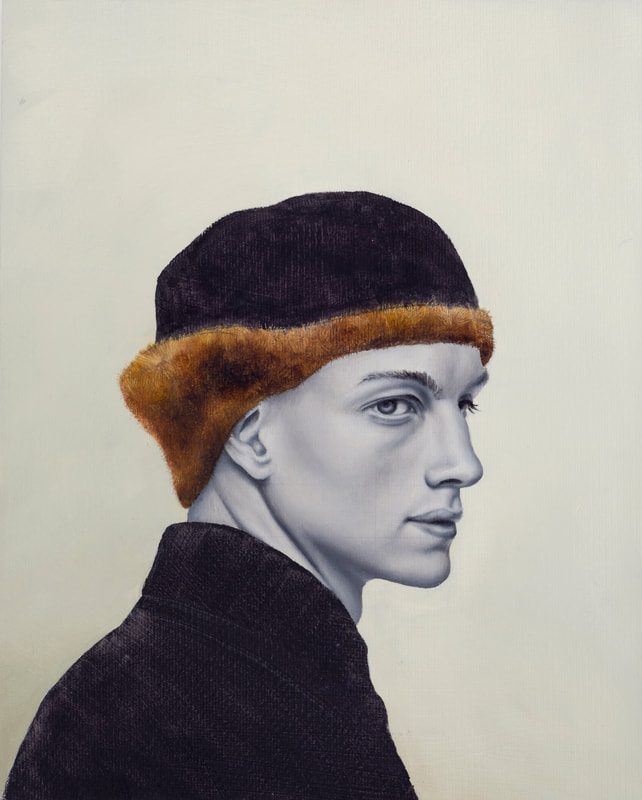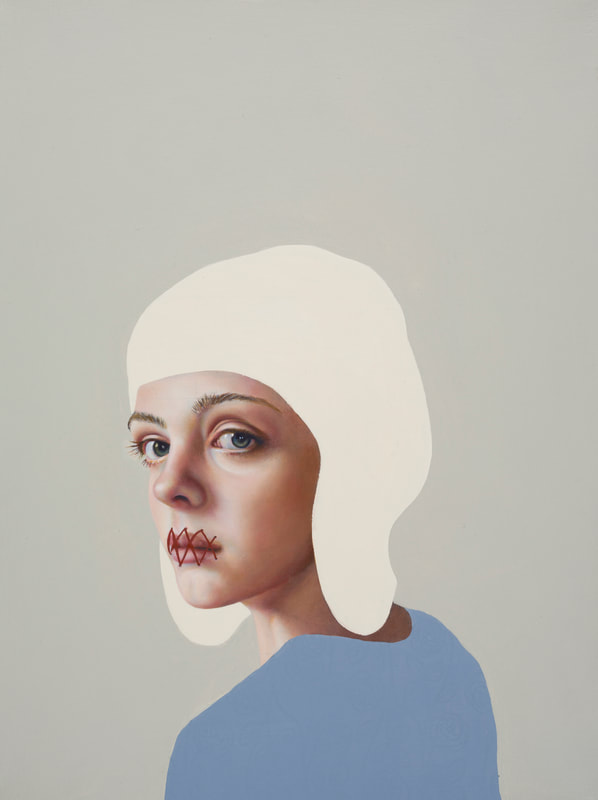|
THE WORK OF PIPPA YOUNG IS BUILT UPON THE RENAISSANCE, INCORPORATING OTHER MEDIA, LINES AND TEXTURE, SIMULATING ABSTRACTION.
MARIE BERTELSEN | ARTICULATE #23 | APR 2020 The impression Pippa Young’s art gives is modern, nordic, and minimalistic. If her art were a tree, it would be birch. The eye catches white, grey, and various lines which are typically black. Besides, there are a few colours around, some red spots here, a bit of blue, or green, which would be the leaves on the birch tree, which again gives the eye a break. These colours lets you focus momentarily. Young’s media is typically oil painting, pencil or graphite drawings. More specifically it can be blank, completely white backgrounds with surfaces copy pasted in. It incorporates nature, but in a tame and controlled version. We zoom in and out of different complexities where we can study the face in detail, really focus on the shadows, contrasts and subtle colour differences.
The person in the paintings has a lot of expression and depth. But then the eye catches a pattern which covers a greater surface, and we have to let the eye zoom out again and uncover the patterns. It confuses - but in a way, we perhaps seek and let us get carried away with.
Young’s art is thus a collaboration of simple, pale colours and strong colours and expressions of the people Pippa Young choose to include. Her artistic expression is consistent across her works - typically being still pictures of pale nymphs with a christian, medieval atmosphere in a modern, flower feminine version. |
COMPOSITION
Young mentions the renaissance as being her obvious inspiration. But her art builds on this by incorporating other media, lines, texture, which perhaps is exactly necessary, since the modern human has become used to abstraction, confusion, and changeability. When creating, Young takes a figure or pose from its original work (for instance a classical portrait) and re-contextualizes it by placing it next to something, which could be imaginary, like a shell or a white collar. Thereby she is able to find modern meanings in an already familiar imaginary, she explains. Young starts with the figure, which is pre-though, and paints layer onto layer, where after the process makes it possible for the meaning behind the painting to shift, so that the idea turns out to be something else than originally intended. Things that can give inspiration to an artwork could be a brochure, a facial expression, a pattern fabric, a figure from an old painting or simply two colours next to each other. Compositionally Young challenges herself by making an awkward pose, where after she changes colours or graphical shapes and thereby regains balance in the composition.
PAPER DOLLS AND POP ART Her art can seem like a myriad of templates, which is put into a classical portrait. It could, with a bit of a nerve, be said to look like paper dolls. As if she had cut out a person, glued on a blank surface for then to mix up the texture, nuance, and motive. These surfaces in the pieces are blank, unfinished, but it is exactly this, which makes the art finished. The style has something pop art to it. It needs to be understood in the process of creating the pieces, where Young re creates by taking something classical and reinterpreting it. |
You could argue that all art can be seen as a reinterpretation of your understanding of reality. But Young makes quite a jump. It is kitsch, but the time horizon is stretched. Instead of, for instance, Roy Liechtenstein (1923-1997) taking comic books from the 40’s and making art two decades after, Young jumps several centuries long from 1600 to 2000. Therefore, artists she is inspired by are German painter Hans Holbein (1497-1543), Spanish painter Jusepe de Ribera (1591-1652), the Flamish Barroque artist Anthony Van Dijk (1599-1641), the Dutch painter Johannes Vermeer (1632-1675), the Spanish painter Diego Velasquez (1599-1660), but also modern artists, such as the American painter Robert Rauschenberg (1925-2008), the British painters David Hockney (b. 1937), Peter Lanyon (1918-1964), Keith Vaughan (1912-1977) and Prunella Clough (1919-1999).
OUR WORLD AND INFORMATION
To fully understand Young’s art, we need to understand her view on the world. Young mentions our way of getting information as being fragmented. Through tv, social media, internet, magazines, commercials we get a complex and forever changing stream of information. Our working, mediation and psychological response to this is what inspires and interests Young. She herself mentions being sceptical towards what we as humans take for granted. She says our knowledge of the world needs to be understood as subjective and second-hand. In line with Plato's cave story, Young’s art tries to showcase our psychology, existence, self perception, which may be hinted in the titles she gives her work, such as ‘Self Doubt’ and ‘Self Removed’. Almost in an ascetic way, Young instead gives us blank surfaces, copy pasted out, where we instead consider a simple concept in-depth. Young says she hopefully can communicate the complexities we face by living today and the fragility we feel as human beings. This article about Pippa Young takes part of magazine, ARTICULATE #23. Read, download or order your print version of the full publication below
|
SUPPORTARTICULATE
www.articulate.nu SUPPORT Monday - Friday 8:00 - 16:00 [email protected] +45 30 48 19 81 Head Quarters VAT DK40953191 |
|







